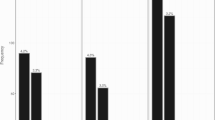Abstract
Aim
Was to investigate hypodontia and supernumerary teeth, in the same individual, which is termed ‘concomitant hypo-hyperodontia’ (CHH) and the frequency of CHH in a large sample of non-syndromic orthodontic patients.
Methods
In this retrospective study, the records were reviewed of 1236 Turkish orthodontic patients treated between 1994 and 2003 at Marmara University, Paediatric Clinics. Data were collected and analysed for differences in the distribution of hypodontia and supernumerary teeth, sex, and malocclusion type.
Results
A total of 1236 orthodontic patients were included in this study. The mean age of children was 17.05 years (SD = 2.5). The prevalence of hypodontia was 7 % (82) and was more frequently found in girls. Concomitant hypo-hyperodontia was found in 9 children, involving 8 boys and 1 girl. The frequency of mesiodens in hypodontia patients with Class I, II, and Class III malocclusions was 3 (3 boys), 5 (5 boys) and 1 (1 girl), respectively. CHH prevalence was found 0.7 % (9 patients). The gender ratio was 0.2:1.1 for CHH.
Conclusions
Supernumerary teeth may lead to some clinical problems including malocclusions, aesthetic and functional complaints, and also psychological problems. Early diagnosis of the condition and multidisciplinary approach for management of such cases is recommended.


Similar content being viewed by others
References
Acerbi AG, Freitas C, Magalhaes MHCG. Prevalence of numeric anomalies in the permanent dentition of patients with Down syndrome. Spec Care Dentist. 2001;21(2):75–8.
Anthonappa RP, Lee CK, Yiu CK, King NM. Hypohyperdontia: literature review and report of seven cases. Oral Surg Oral Med Oral Pathol Oral Radiol Endod. 2008;106(5):24–30.
Camilleri GE. Concomitant hypodontia and hyperodontia. Case report. Br Dent J. 1967;123(7):338–9.
Dastjerdi VE, Farahani BA, Mahdian M, Amini N. Non-syndromic hypodontia in an Iranian orthodontic population. J Oral Sci. 2010;52(3):455–61.
Davis PJ. Hypodontia and hyperodontia of the permanent teeth in Hong Kong schoolchildren. Community Dent Oral Epidemiol. 1987;15:218–20.
Endo T, Ozoe R, Kubota M, Akiyama M, Shimooka S. A survey of hypodontia in Japanese orthodontic patients. Am J Orthod Dentofacial Orthop. 2006;129:29–35.
Fekonja A. Hypodontia in orthodontically treated children. Eur J Orthod. 2005;27:457–60.
Gibson AC. Concomitant hypo-hyperodontia. Br J Orthod. 1979;6:101–5.
Gomes RR, da Fonseca JA, Paula LM, Faber J, Acevedo AC. Prevalence of hypodontia in orthodontic patients in Brasilia. Eur J Orthod. 2010;32:302–6.
Hattab FN, Yassin OM, Sasa IS. Oral manifestations of Ellis-van Creveld syndrome: report of two siblings with unusual dental anomalies. J Clin Pediatr Dent. 1998;22(2):159–65.
Kazanci F, Celikoglu M, Miloglu O, Ceylan I, Kamak H. Frequency and distribution of developmental anomalies in the permanent teeth of a Turkish orthodontic patient population. J Dent Sci. 2011;6(2):82–9.
Kim SG, Lee SH. Mesiodens. A clinical and radiographic study. J Dent Child. 2003;70(1):58–60.
Mallineni SK, Jayaraman J, Yiu CK, King NM. Concomitant occurrence of hypohyperdontia in a patient with Marfan syndrome: a review of the literature and report of a case. J Invest Clin Dent. 2012;3:253–7.
Mallineni SK, Nuvvula S, Cheung ACH, Kunduru R. A comprehensive review of the literature and data analysis on hypo-hyperdontia. J Oral Sci. 2014;56(4):295–302.
Marya CM, Sharma G, Parashar VP, Dahiya V, Gupta A. Mandibular midline supernumerary tooth associated with agenesis of permanent central incisors: a diagnostic conundrum. Stomatologija. 2012;14:65–8.
Mattheeuws N, Dermaut L, Martens G. Has hypodontia increased in Caucasians during the 20th century? A meta-analysis. Eur J Orthod. 2004;26:99–103.
Nirmala G, Mallineni SK, Nuvvula S. Pre-maxillary hypo hyperdontia: report of a rare case. Rom J Morphol Embryol. 2013a;54(2):443–5.
Nirmala SV, Sandeep C, Nuvvula S, Mallineni SK. Mandibular hypo-hyperdontia: a report of three cases. J Int Soc Prev Community Dent. 2013b;3:92–6.
Novak J. Simultaneous occurrence of hypodontia and hyperodontia. Sbornik Vedeckych Praci Lekarske Fakulty Karlovy Univerzity V Hradci. 1974;17:467–71.
Nuvvula S, Kiranmayi M, Shilpa G, Nirmala SV. Hypohyperdontia: agenesis of three third molars and mandibular centrals associated with midline supernumerary tooth in mandible. Contemp Clin Dent. 2010;1(3):136–41.
Raghavan VH. Mandibular mesiodens with agenesis of central incisors—a rare association. Nigerian Dent J. 2009;17(1):27–8.
Rajab LD, Hamdan MAM. Supernumerary teeth: review of the literature and a survey of 152 cases. Int J Paediatr Dent. 2002;12:244–54.
Ratna R. Numeric anomalies of teeth in concomitant hypodontia and hyperdontia. J Craniofac Genet Dev Biol. 1988;8(3):245–51.
Russell KA, Folwarzcna MA. Mesiodens. Diagnosis and management of a common supernumerary tooth. J Can Dent Assoc. 2003;69:362–6.
Ribbons JW. An incisiform supernumerary in an unusual site. A case report. Br Dent J. 1970;129:174.
Sharma A. Mandibular midline supernumerary tooth: a case report. J Indian Soc Pedod Prev Dent. 2001;19:143–4.
Sharma A. A rare case of concomitant hypo-hyperdontia in identical twins. J Indian Soc Pedod Prev Dent. 2008;26:79–81.
Silva Meza R. Radiographic assessment of congenitally missing teeth in orthodontic patients. Int J Paediatr Dent. 2003;13:112–6.
Thongudomporn U, Freer TJ. Prevalence of dental anomalies in orthodontic patients. Aust Dent J. 1998;43:395–8.
Uslu O, Akcam MO, Evirgen S, Cebeci I. Prevalence of dental anomalies in various malocclusions. Am J Orthod Dentofacial Orthop. 2009;135:328–35.
Varela M, Arrieta P, Ventureira C. Non-syndromic concomitant hypodontia and supernumerary teeth in an orthodontic population. Eur J Orthod. 2009;31(6):632–7.
Zhu JF, Crevoisier R, Henry RJ. Congenitally missing permanent lateral incisors in conjunction with a supernumerary tooth: case report. Pediatr Dent. 1996;18:64–6.
Author information
Authors and Affiliations
Corresponding author
Rights and permissions
About this article
Cite this article
Gokkaya, B., Kargul, B. Prevalence of concomitant hypo-hyperdontia in a group of Turkish orthodontic patients. Eur Arch Paediatr Dent 17, 53–57 (2016). https://doi.org/10.1007/s40368-015-0201-0
Received:
Accepted:
Published:
Issue Date:
DOI: https://doi.org/10.1007/s40368-015-0201-0




